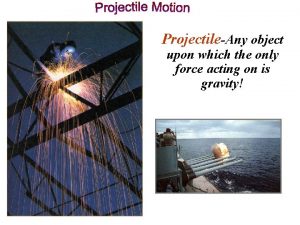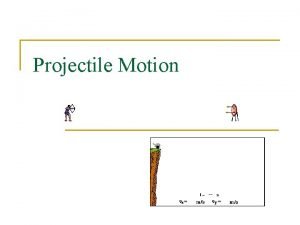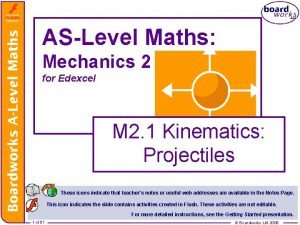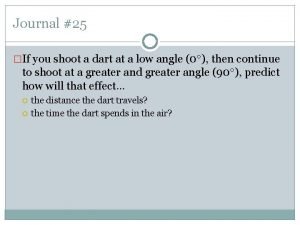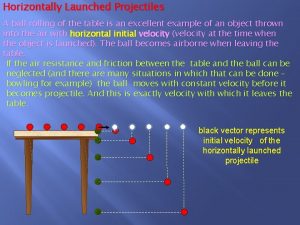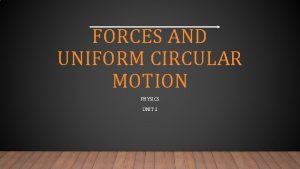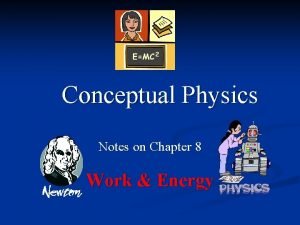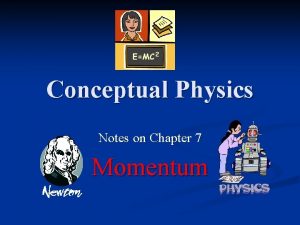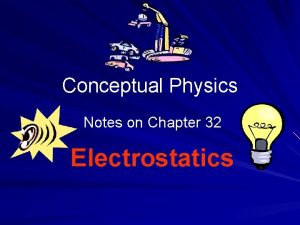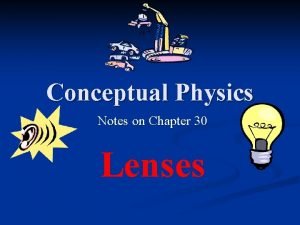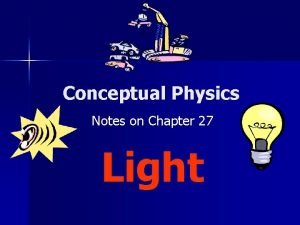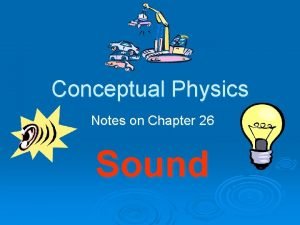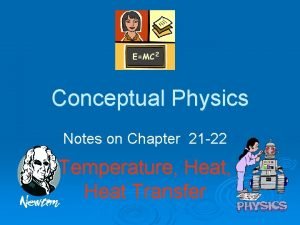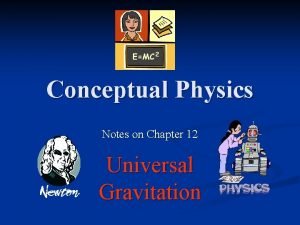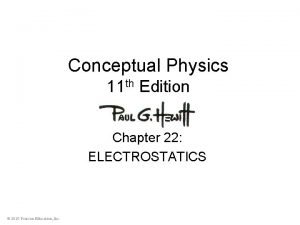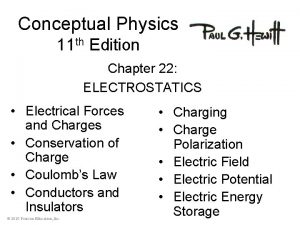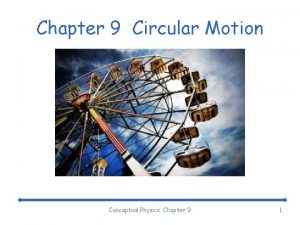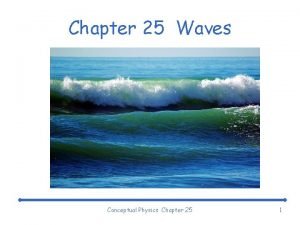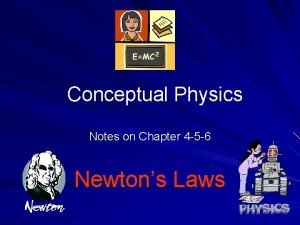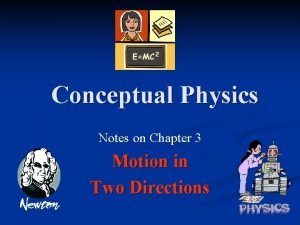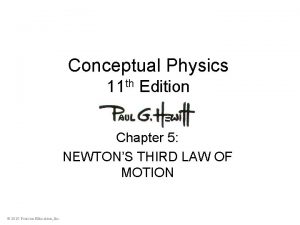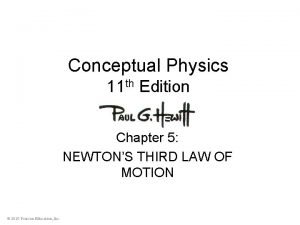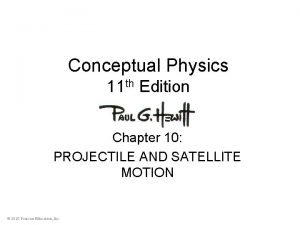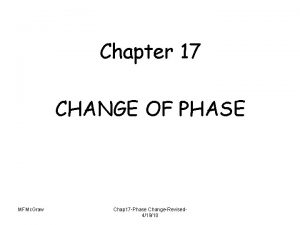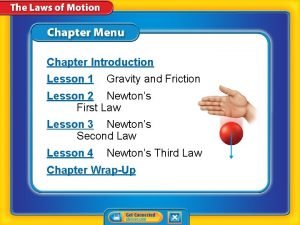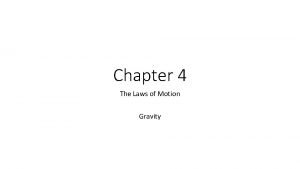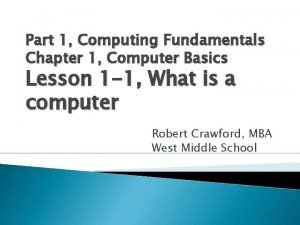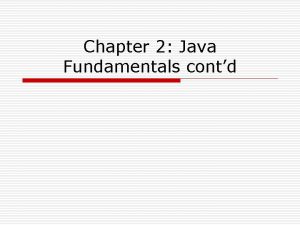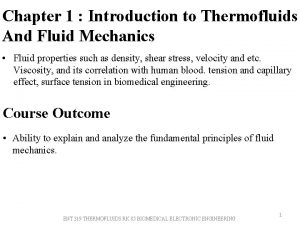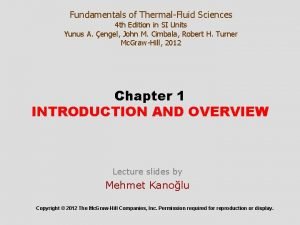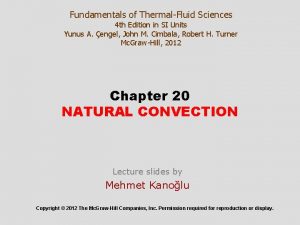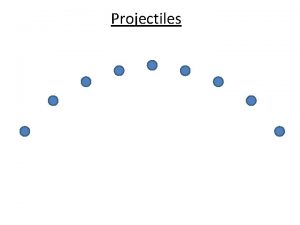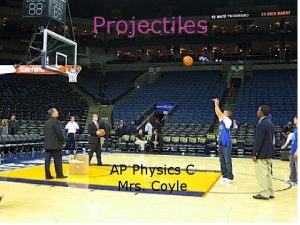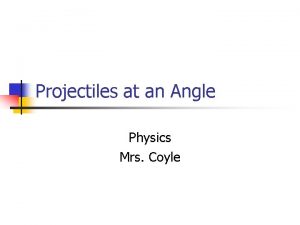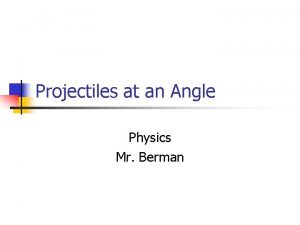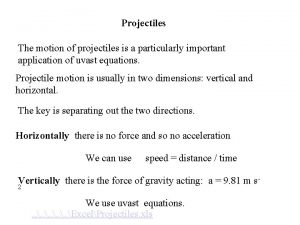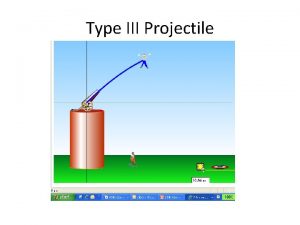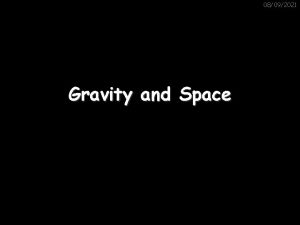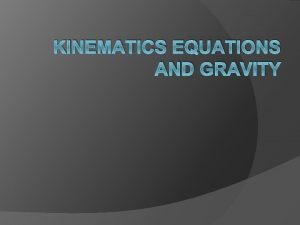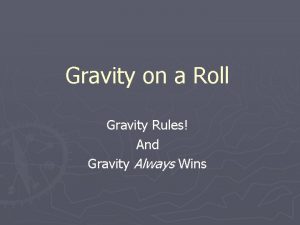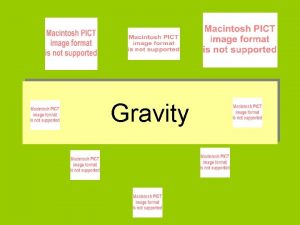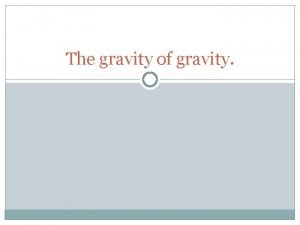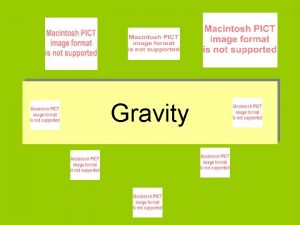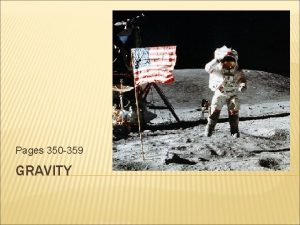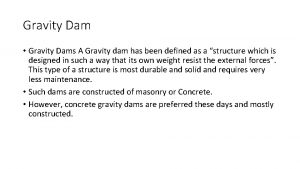Conceptual Physics Fundamentals Chapter 6 GRAVITY PROJECTILES AND









































































- Slides: 73

Conceptual Physics Fundamentals Chapter 6: GRAVITY, PROJECTILES, AND SATELLITES 1 Copyright © 2008 Pearson Education, Inc. , publishing as Pearson Addison-Wesley

This lecture will help you understand: § § § The Universal Law of Gravity The Universal Gravitational Constant, G Gravity and Distance: The Inverse-Square Law Weight and Weightlessness Universal Gravitation Projectile Motion Fast-Moving Projectiles—Satellites Circular Satellite Orbits Elliptical Orbits Energy Conservation and Satellite Motion Escape Speed 2 Copyright © 2008 Pearson Education, Inc. , publishing as Pearson Addison-Wesley

Gravity, Projectiles, and Satellites “The greater the velocity…with (a stone) is projected, the farther it goes before it falls to the Earth. We may therefore suppose the velocity to be so increased, that it would describe an arc of 1, 2, 5, 100, 1000 miles before it arrived at the Earth, till at last, exceeding the limits of the Earth, it should pass into space without touching. ” —Isaac Newton 3 Copyright © 2008 Pearson Education, Inc. , publishing as Pearson Addison-Wesley

The Universal Law of Gravity § Newton was not the first to discover gravity. Newton discovered that gravity is universal. § Legend—Newton, sitting under an apple tree, realized that the force between Earth and the apple is the same as that between moons and planets and everything else. 4 Copyright © 2008 Pearson Education, Inc. , publishing as Pearson Addison-Wesley

The Universal Law of Gravity Law of universal gravitation § Everything pulls on everything else. § Every body attracts every other body with a force that is directly proportional to the product of their masses and inversely proportional to the square of the distance separating them. 5 Copyright © 2008 Pearson Education, Inc. , publishing as Pearson Addison-Wesley

The Universal Law of Gravity § in equation form: where m is mass of object and d is the distance between their centers examples: o The greater the masses m 1 and m 2 of two bodies, the greater the force of attraction between them. o The greater the distance of separation d, the weaker the force of attraction. 6 Copyright © 2008 Pearson Education, Inc. , publishing as Pearson Addison-Wesley

The Universal Law of Gravity CHECK YOUR NEIGHBOR Newton’s most celebrated synthesis was and is of ______. A. B. C. D. earthly and heavenly laws weight on Earth and weightlessness in outer space masses and distances the paths of tossed rocks and the paths of satellites 7 Copyright © 2008 Pearson Education, Inc. , publishing as Pearson Addison-Wesley

The Universal Law of Gravity CHECK YOUR ANSWER Newton’s most celebrated synthesis was and is of ______. A. B. C. D. earthly and heavenly laws weight on Earth and weightlessness in outer space masses and distances the paths of tossed rocks and the paths of satellites Comment: This synthesis provided hope that other natural phenomena followed universal laws, and ushered in the “Age of Enlightenment. ” 8 Copyright © 2008 Pearson Education, Inc. , publishing as Pearson Addison-Wesley

The Universal Gravitational Constant, G § Gravity is the weakest of four known fundamental forces. § With the gravitational constant G, we have the equation: § Universal gravitational constant equation is: G = 6. 67 10 -11 Nm 2/kg 2 § Once value was known, mass of Earth was calculated as 6 1024 kg. 9 Copyright © 2008 Pearson Education, Inc. , publishing as Pearson Addison-Wesley

The Universal Gravitational Constant, G CHECK YOUR NEIGHBOR The universal gravitational constant, G, which links force to mass and distance, is similar to the familiar constant ______. A. B. C. D. g acceleration due to gravity speed of uniform motion 10 Copyright © 2008 Pearson Education, Inc. , publishing as Pearson Addison-Wesley

The Universal Gravitational Constant, G CHECK YOUR ANSWER The universal gravitational constant, G, which links force to mass and distance, is similar to the familiar constant ______. A. B. C. D. g acceleration due to gravity speed of uniform motion Explanation: Just as relates the circumference of a circle to its diameter, G relates force to mass and distance. 11 Copyright © 2008 Pearson Education, Inc. , publishing as Pearson Addison-Wesley

Gravity and Distance: The Inverse-Square Law Inverse-square law § relates the intensity of an effect to the inversesquare of the distance from the cause § in equation form: intensity = 1/distance 2 § for increases in distance, there are decreases in force § even at great distances, force approaches but never reaches zero 12 Copyright © 2008 Pearson Education, Inc. , publishing as Pearson Addison-Wesley

Inverse-Square Law 13 Copyright © 2008 Pearson Education, Inc. , publishing as Pearson Addison-Wesley

Inverse-Square Law 14 Copyright © 2008 Pearson Education, Inc. , publishing as Pearson Addison-Wesley

Gravity and Distance: The Inverse-Square Law CHECK YOUR NEIGHBOR The force of gravity between two planets depends on their ______. A. B. C. D. masses and distance apart planetary atmospheres rotational motions All of the above 15 Copyright © 2008 Pearson Education, Inc. , publishing as Pearson Addison-Wesley

Gravity and Distance: The Inverse-Square Law CHECK YOUR ANSWER The force of gravity between two planets depends on their ______. A. B. C. D. masses and distance apart planetary atmospheres rotational motions All of the above Explanation: The equation for gravitational force, cites only masses and distances as variables. Rotation and atmospheres are irrelevant. 16 Copyright © 2008 Pearson Education, Inc. , publishing as Pearson Addison-Wesley

Gravity and Distance: The Inverse-Square Law CHECK YOUR NEIGHBOR If the masses of two planets are each somehow doubled, the force of gravity between them ______. A. B. C. D. doubles quadruples reduces by half reduces by one-quarter 17 Copyright © 2008 Pearson Education, Inc. , publishing as Pearson Addison-Wesley

Gravity and Distance: The Inverse-Square Law CHECK YOUR ANSWER If the masses of two planets are each somehow doubled, the force of gravity between them ______. A. B. C. D. doubles quadruples reduces by half reduces by one-quarter Explanation: Note that both masses double. Then double = quadruple. 18 Copyright © 2008 Pearson Education, Inc. , publishing as Pearson Addison-Wesley

Gravity and Distance: The Inverse-Square Law CHECK YOUR NEIGHBOR If the mass of one planet is somehow doubled, the force of gravity between it and a neighboring planet ______. A. B. C. D. doubles quadruples reduces by half reduces by one-quarter 19 Copyright © 2008 Pearson Education, Inc. , publishing as Pearson Addison-Wesley

Gravity and Distance: The Inverse-Square Law CHECK YOUR ANSWER If the mass of one planet is somehow doubled, the force of gravity between it and a neighboring planet _____. A. B. C. D. doubles quadruples reduces by half reduces by one-quarter Explanation: Let the equation guide your thinking: Note that if one mass doubles, then the force between them doubles. 20 Copyright © 2008 Pearson Education, Inc. , publishing as Pearson Addison-Wesley

Weight and Weightlessness Weight § force of an object exerts against a supporting surface examples: o standing on a scale in an elevator accelerating downward, less compression in scale springs; weight is less o standing on a scale in an elevator accelerating upward, more compression in scale springs; weight is greater o at constant speed in an elevator, no change in weight 21 Copyright © 2008 Pearson Education, Inc. , publishing as Pearson Addison-Wesley

Weight and Weightlessness § no support force, as in free-fall example: Astronauts in orbit are without support forces and are in a continual state of weightlessness. 22 Copyright © 2008 Pearson Education, Inc. , publishing as Pearson Addison-Wesley

Weight and Weightlessness 23 Copyright © 2008 Pearson Education, Inc. , publishing as Pearson Addison-Wesley

Weight and Weightlessness CHECK YOUR NEIGHBOR When an elevator accelerates upward, your weight reading on a scale is ______. A. B. C. D. greater less zero the normal weight 24 Copyright © 2008 Pearson Education, Inc. , publishing as Pearson Addison-Wesley

Weight and Weightlessness CHECK YOUR ANSWER When an elevator accelerates upward, your weight reading on a scale is ______. A. B. C. D. greater less zero the normal weight Explanation: The support force pressing on you is greater, so you weigh more. 25 Copyright © 2008 Pearson Education, Inc. , publishing as Pearson Addison-Wesley

Weight and Weightlessness CHECK YOUR NEIGHBOR When an elevator accelerates downward, your weight reading is ______. A. B. C. D. greater less zero the normal weight 26 Copyright © 2008 Pearson Education, Inc. , publishing as Pearson Addison-Wesley

Weight and Weightlessness CHECK YOUR ANSWER When an elevator accelerates downward, your weight reading is ______. A. B. C. D. greater less zero the normal weight Explanation: The support force pressing on you is less, so you weigh less. Question: Would you weigh less in an elevator that moves downward at constant velocity? 27 Copyright © 2008 Pearson Education, Inc. , publishing as Pearson Addison-Wesley

Weight and Weightlessness CHECK YOUR NEIGHBOR When the elevator cable breaks, the elevator falls freely, so your weight reading is ______. A. B. C. D. greater less zero the normal weight 28 Copyright © 2008 Pearson Education, Inc. , publishing as Pearson Addison-Wesley

Weight and Weightlessness CHECK YOUR ANSWER When the elevator cable breaks, the elevator falls freely, so your weight reading is ______. A. B. C. D. greater less zero the normal weight Explanation: There is still a downward gravitational force acting on you, but gravity is not felt as weight because there is no support force, so your weight is zero. 29 Copyright © 2008 Pearson Education, Inc. , publishing as Pearson Addison-Wesley

Weight and Weightlessness CHECK YOUR NEIGHBOR If you weigh yourself in an elevator, you’ll weigh more when the elevator ______. A. B. C. D. moves upward moves downward accelerates upward All of the above 30 Copyright © 2008 Pearson Education, Inc. , publishing as Pearson Addison-Wesley

Weight and Weightlessness CHECK YOUR ANSWER If you weigh yourself in an elevator, you’ll weigh more when the elevator ______. A. B. C. D. moves upward moves downward accelerates upward All of the above Explanation: The support provided by the floor of an elevator is the same whether the elevator is at rest or moving at constant velocity. Only accelerated motion affects weight. 31 Copyright © 2008 Pearson Education, Inc. , publishing as Pearson Addison-Wesley

Universal Gravitation Universal gravitation § everything attracts everything else example: Earth is round because of gravitation—all parts of Earth have been pulled in, making the surface equidistant from the center. § The universe is expanding and accelerating outward. 32 Copyright © 2008 Pearson Education, Inc. , publishing as Pearson Addison-Wesley

Projectile Motion § Without gravity, a tossed object follows a straight -line path. § With gravity, the same object tossed at an angle follows a curved path. Projectile § any object that moves through the air or space under the influence of gravity, continuing in motion by its own inertia 33 Copyright © 2008 Pearson Education, Inc. , publishing as Pearson Addison-Wesley

Projectile Motion Projectile motion is a combination of § a horizontal component § a vertical component 34 Copyright © 2008 Pearson Education, Inc. , publishing as Pearson Addison-Wesley

Projectile Motion Projectiles launched horizontally Important points: § horizontal component of velocity doesn’t change (when air drag is negligible) o ball travels the same horizontal distance in equal times (no component of gravitational force acting horizontally) o remains constant 35 Copyright © 2008 Pearson Education, Inc. , publishing as Pearson Addison-Wesley

Projectile Motion § Vertical positions become farther apart with time. o gravity acts downward, so ball accelerates downward § Curvature of path is the combination of horizontal and vertical components of motion. 36 Copyright © 2008 Pearson Education, Inc. , publishing as Pearson Addison-Wesley

Projectile Motion Parabola § curved path of a projectile that undergoes acceleration only in the vertical direction, while moving horizontally at a constant speed 37 Copyright © 2008 Pearson Education, Inc. , publishing as Pearson Addison-Wesley

Projectile Motion Projectiles launched at an angle § paths of stone thrown at an angle upward and downward o Vertical and horizontal components are independent of each other. 38 Copyright © 2008 Pearson Education, Inc. , publishing as Pearson Addison-Wesley

Projectile Motion § paths of a cannonball shot at an upward angle o Vertical distance that a stone falls is the same vertical distance it would have fallen if it had been dropped from rest and been falling for the same amount of time (5 t 2). 39 Copyright © 2008 Pearson Education, Inc. , publishing as Pearson Addison-Wesley

Projectile Motion § paths of projectile following a parabolic trajectory o horizontal component along trajectory remains unchanged o only vertical component changes o velocity at any point is computed with the Pythagorean theorem (diagonal of rectangle) 40 Copyright © 2008 Pearson Education, Inc. , publishing as Pearson Addison-Wesley

Projectile Motion § different horizontal distances o same range is obtained from two different launching angles when the angles add up to 90° • object thrown at an angle of 60 has the same range as if it were thrown at an angle of 30 41 Copyright © 2008 Pearson Education, Inc. , publishing as Pearson Addison-Wesley

Projectile Motion § different horizontal distances (continued) o maximum range occurs for ideal launch at 45 o with air resistance, the maximum range occurs for a baseball batted at less than 45 above the horizontal o with air resistance the maximum range occurs when a golf ball that is hit at an angle less than 38 § Without air resistance, the time for a projectile to reach maximum height is the same as the time for it to return to its initial level. 42 Copyright © 2008 Pearson Education, Inc. , publishing as Pearson Addison-Wesley

Projectile Motion CHECK YOUR NEIGHBOR The velocity of a typical projectile can be represented by horizontal and vertical components. Assuming negligible air resistance, the horizontal component along the path of the projectile ______. A. B. C. D. increases decreases remains the same Not enough information 43 Copyright © 2008 Pearson Education, Inc. , publishing as Pearson Addison-Wesley

Projectile Motion CHECK YOUR ANSWER The velocity of a typical projectile can be represented by horizontal and vertical components. Assuming negligible air resistance, the horizontal component along the path of the projectile ______. A. B. C. D. increases decreases remains the same Not enough information Explanation: Since there is no force horizontally, no horizontal acceleration occurs. Copyright © 2008 Pearson Education, Inc. , publishing as Pearson Addison-Wesley 44

Projectile Motion CHECK YOUR NEIGHBOR When no air resistance acts on a fast-moving baseball, its acceleration is ______. A. B. C. D. downward, g due to a combination of constant horizontal motion and accelerated downward motion opposite to the force of gravity centripetal 45 Copyright © 2008 Pearson Education, Inc. , publishing as Pearson Addison-Wesley

Projectile Motion CHECK YOUR ANSWER When no air resistance acts on a fast-moving baseball, its acceleration is ______. A. B. C. D. downward, g due to a combination of constant horizontal motion and accelerated downward motion opposite to the force of gravity centripetal 46 Copyright © 2008 Pearson Education, Inc. , publishing as Pearson Addison-Wesley

Projectile Motion CHECK YOUR NEIGHBOR A ball tossed at an angle of 30 with the horizontal will go as far downrange as one that is tossed at the same speed at an angle of ______. A. B. C. D. 45 60 75 None of the above 47 Copyright © 2008 Pearson Education, Inc. , publishing as Pearson Addison-Wesley

Projectile Motion CHECK YOUR ANSWER A ball tossed at an angle of 30 with the horizontal will go as far downrange as one that is tossed at the same speed at an angle of ______ A. B. C. D. 45 60 75 None of the above Explanation: Same initial-speed projectiles have the same range when their launching angles add up to 90. Its explanation involves a bit of trigonometry—which, in the interest of time, we’ll not pursue here. 48 Copyright © 2008 Pearson Education, Inc. , publishing as Pearson Addison-Wesley

Fast-Moving Projectiles— Satellites § Satellite motion is an example of a high-speed projectile. § A satellite is simply a projectile that falls around Earth rather than into it. o Sufficient tangential velocity is needed for orbit. o With no resistance to reduce speed, a satellite goes around Earth indefinitely. 49 Copyright © 2008 Pearson Education, Inc. , publishing as Pearson Addison-Wesley

Fast-Moving Projectiles—Satellites CHECK YOUR NEIGHBOR As the ball leaves the girl’s hand, one second later it will have fallen ______. A. B. C. D. 10 meters 5 meters below the dashed line less than 5 meters below the straight-line path None of the above 50 Copyright © 2008 Pearson Education, Inc. , publishing as Pearson Addison-Wesley

Fast-Moving Projectiles—Satellites CHECK YOUR ANSWER As the ball leaves the girl’s hand, one second later it will have fallen ______. A. B. C. D. 10 meters 5 meters below the dashed line less than 5 meters below the straight-line path None of the above Comment: Whatever the speed, the ball will fall a vertical distance of 5 meters below the dashed line. 51 Copyright © 2008 Pearson Education, Inc. , publishing as Pearson Addison-Wesley

Circular Satellite Orbits Satellite in circular orbit § speed o must be great enough to ensure that its falling distance matches Earth’s curvature o is constant—only direction changes o unchanged by gravity 52 Copyright © 2008 Pearson Education, Inc. , publishing as Pearson Addison-Wesley

Circular Satellite Orbits § positioning o beyond Earth’s atmosphere, where air resistance is almost totally absent example: space shuttles are launched to altitudes of 150 kilometers or more, to be above air drag 53 Copyright © 2008 Pearson Education, Inc. , publishing as Pearson Addison-Wesley

Circular Satellite Orbits § motion o moves in a direction perpendicular to the force of gravity acting on it § period for complete orbit o about Earth • for satellites close to Earth—about 90 minutes • for satellites at higher altitudes—longer periods 54 Copyright © 2008 Pearson Education, Inc. , publishing as Pearson Addison-Wesley

Circular Satellite Orbits Curvature of the Earth § Earth’s surface drops a vertical distance of 5 meters for every 8, 000 meters tangent to the surface. 55 Copyright © 2008 Pearson Education, Inc. , publishing as Pearson Addison-Wesley

Circular Satellite Orbits What speed will allow the ball to clear the gap? 56 Copyright © 2008 Pearson Education, Inc. , publishing as Pearson Addison-Wesley

Circular Satellite Orbits CHECK YOUR NEIGHBOR When you toss a projectile sideways, it curves as it falls. It will be an Earth satellite if the curve it makes _____. A. B. C. D. matches the curved surface of Earth results in a straight line spirals out indefinitely None of the above 57 Copyright © 2008 Pearson Education, Inc. , publishing as Pearson Addison-Wesley

Circular Satellite Orbits CHECK YOUR ANSWER When you toss a projectile sideways, it curves as it falls. It will be an Earth satellite if the curve it makes ______. A. B. C. D. matches the curved surface of Earth results in a straight line spirals out indefinitely None of the above Explanation: For an 8 -km tangent, Earth curves downward 5 m. Therefore, a projectile traveling horizontally at 8 km/s will fall 5 m in that time, and follow the curve of Earth. 58 Copyright © 2008 Pearson Education, Inc. , publishing as Pearson Addison-Wesley

Circular Satellite Orbits CHECK YOUR NEIGHBOR When a satellite travels at a constant speed, the shape of its path is ______. A. B. C. D. a circle an ellipse an oval that is almost elliptical a circle with a square corner, as seen throughout your book 59 Copyright © 2008 Pearson Education, Inc. , publishing as Pearson Addison-Wesley

Circular Satellite Orbits CHECK YOUR ANSWER When a satellite travels at a constant speed, the shape of its path is ______. A. B. C. D. a circle an ellipse an oval that is almost elliptical a circle with a square corner, as seen throughout your book 60 Copyright © 2008 Pearson Education, Inc. , publishing as Pearson Addison-Wesley

Circular Satellite Orbits A payload into orbit requires control over § direction of rocket o initially, rocket is fired vertically, then tipped o once above the atmosphere, the rocket is aimed horizontally § speed of rocket o payload is given a final thrust to orbital speed of 8 km/s to fall around Earth and become an Earth satellite 61 Copyright © 2008 Pearson Education, Inc. , publishing as Pearson Addison-Wesley

Elliptical Orbits § A projectile just above the atmosphere will follow an elliptical path if given a horizontal speed greater than 8 km/s. Ellipse o specific curve, an oval path example: A circle is a special case of an ellipse when its two foci coincide. 62 Copyright © 2008 Pearson Education, Inc. , publishing as Pearson Addison-Wesley

Elliptical Orbits Elliptical orbit § speed of satellite varies o initially, if speed is greater than needed for circular orbit, satellite overshoots a circular path and moves away from Earth o satellite loses speed and then regains it as it falls back toward Earth o it rejoins its original path with the same speed it had initially o procedure is repeated 63 Copyright © 2008 Pearson Education, Inc. , publishing as Pearson Addison-Wesley

Elliptical Orbits CHECK YOUR NEIGHBOR The speed of a satellite in an elliptical orbit _____. A. B. C. D. varies remains constant acts at right angles to its motion All of the above 64 Copyright © 2008 Pearson Education, Inc. , publishing as Pearson Addison-Wesley

Elliptical Orbits CHECK YOUR ANSWER The speed of a satellite in an elliptical orbit ______. A. B. C. D. varies remains constant acts at right angles to its motion All of the above 65 Copyright © 2008 Pearson Education, Inc. , publishing as Pearson Addison-Wesley

Energy Conservation and Satellite Motion Recall the following: § object in motion possesses KE due to its motion § object above Earth’s surface possesses PE by virtue of its position § satellite in orbit possesses KE and PE o sum of KE and PE is constant at all points in the orbit 66 Copyright © 2008 Pearson Education, Inc. , publishing as Pearson Addison-Wesley

Energy Conservation and Satellite Motion PE, KE, and speed in • circular orbit o unchanged o distance between the satellite and center of the attracting body does not change—PE is the same everywhere o no component of force acts along the direction of motion— no change in speed and KE 67 Copyright © 2008 Pearson Education, Inc. , publishing as Pearson Addison-Wesley

Energy Conservation and Satellite Motion § elliptical orbit o varies • PE is greatest when the satellite is farthest away (apogee). • PE is least when the satellite is closest (perigee). • KE is least when PE is the most and vice versa. • At every point in the orbit, the sum of KE and PE is the same. 68 Copyright © 2008 Pearson Education, Inc. , publishing as Pearson Addison-Wesley

Energy Conservation and Satellite Motion When a satellite gains altitude and moves against gravitational force, its speed and KE decrease and continues to the apogee. Past the apogee, satellite moves in the same direction as the force component, and speed and KE increases. Increase continues until it’s past the perigee and cycle repeats. 69 Copyright © 2008 Pearson Education, Inc. , publishing as Pearson Addison-Wesley

Escape Speed Escape speed § the initial speed that an object must reach to escape gravitational influence of Earth § 11. 2 kilometers per second from Earth’s surface Escape velocity § is escape speed when direction is involved 70 Copyright © 2008 Pearson Education, Inc. , publishing as Pearson Addison-Wesley

Escape Speed First probe to escape the solar system is Pioneer 10, launched from Earth in 1972. § accomplished by directing the probe into the path of oncoming Jupiter 71 Copyright © 2008 Pearson Education, Inc. , publishing as Pearson Addison-Wesley

Escape Speed CHECK YOUR NEIGHBOR When a projectile achieves escape speed from Earth, it ______. A. B. C. D. forever leaves Earth’s gravitational field outruns the influence of Earth’s gravity, but is never beyond it comes to an eventual stop, returning to Earth at some future time All of the above 72 Copyright © 2008 Pearson Education, Inc. , publishing as Pearson Addison-Wesley

Escape Speed CHECK YOUR ANSWER When a projectile achieves escape speed from Earth, it ______. A. B. C. D. forever leaves Earth’s gravitational field outruns the influence of Earth’s gravity, but is never beyond it comes to an eventual stop, returning to Earth at some future time. All of the above 73 Copyright © 2008 Pearson Education, Inc. , publishing as Pearson Addison-Wesley
 Projectile motion formulas physics
Projectile motion formulas physics Higher physics projectiles
Higher physics projectiles Gravity for dummies and dummies for gravity equations
Gravity for dummies and dummies for gravity equations What is the only force that acts upon projectiles?
What is the only force that acts upon projectiles? Table 2.1.3 horizontal motion description
Table 2.1.3 horizontal motion description A machine fired several projectiles
A machine fired several projectiles Projectiles a level maths
Projectiles a level maths A car a bicycle a mouse and a bug have the same velocity
A car a bicycle a mouse and a bug have the same velocity Refers to the path raised by a projectile during its motion
Refers to the path raised by a projectile during its motion Horizontally launched projectiles
Horizontally launched projectiles Tigershark projectiles
Tigershark projectiles Physics 02-02 weight and gravity answers
Physics 02-02 weight and gravity answers Chapter 8 energy conceptual physics
Chapter 8 energy conceptual physics Conceptual physics chapter 6 momentum
Conceptual physics chapter 6 momentum Conceptual physics chapter 35 electric circuits
Conceptual physics chapter 35 electric circuits Conceptual physics chapter 33
Conceptual physics chapter 33 Chapter 32 conceptual physics
Chapter 32 conceptual physics Conceptual physics chapter 30 lenses pdf
Conceptual physics chapter 30 lenses pdf Chapter 27 light
Chapter 27 light Conceptual physics chapter 26
Conceptual physics chapter 26 Conceptual physics chapter 21
Conceptual physics chapter 21 Conceptual physics chapter 13 universal gravitation
Conceptual physics chapter 13 universal gravitation Conceptual physics momentum
Conceptual physics momentum Conceptual physics chapter 22
Conceptual physics chapter 22 Conceptual physics chapter 22 electrostatics
Conceptual physics chapter 22 electrostatics Circular motion conceptual physics
Circular motion conceptual physics Bow wave aircraft
Bow wave aircraft Conceptual physics chapter 23 electric current
Conceptual physics chapter 23 electric current Conceptual physics chapter 4
Conceptual physics chapter 4 Physics chapter 3 notes
Physics chapter 3 notes Slightly tilted wings of airplanes deflect
Slightly tilted wings of airplanes deflect Conceptual physics chapter 5 newton's third law of motion
Conceptual physics chapter 5 newton's third law of motion Conceptual physics chapter 3 linear motion
Conceptual physics chapter 3 linear motion Conceptual physics projectile motion
Conceptual physics projectile motion Conceptual physics chapter 17 change of phase answers
Conceptual physics chapter 17 change of phase answers Chapter 2 lesson 1 gravity and friction
Chapter 2 lesson 1 gravity and friction Chapter 24 magnetism magnetic fundamentals answers
Chapter 24 magnetism magnetic fundamentals answers Tire wheel and wheel bearing fundamentals
Tire wheel and wheel bearing fundamentals Understanding your health and wellness chapter 1
Understanding your health and wellness chapter 1 Forensic science fundamentals and investigations chapter 6
Forensic science fundamentals and investigations chapter 6 Chapter one understanding health and wellness
Chapter one understanding health and wellness Why does it happen
Why does it happen University physics with modern physics fifteenth edition
University physics with modern physics fifteenth edition Ib physics ia ideas mechanics
Ib physics ia ideas mechanics Chapter 12 section 2 gravity answer key
Chapter 12 section 2 gravity answer key Gravity chapter 4
Gravity chapter 4 Gravity chapter 2
Gravity chapter 2 Chapter 20:3 puncturing the skin to obtain capillary blood
Chapter 20:3 puncturing the skin to obtain capillary blood Nursing chapter 1
Nursing chapter 1 Fundamentals of electric circuits chapter 4 solutions
Fundamentals of electric circuits chapter 4 solutions Fundamentals of corporate finance chapter 6 solutions
Fundamentals of corporate finance chapter 6 solutions Digital fundamentals chapter 4
Digital fundamentals chapter 4 Fundamentals of electric circuits chapter 9 solutions
Fundamentals of electric circuits chapter 9 solutions Fundamentals of electric circuits chapter 7 solutions
Fundamentals of electric circuits chapter 7 solutions Building the right foundations/fundamentals
Building the right foundations/fundamentals Chapter 1 computer fundamentals
Chapter 1 computer fundamentals Fundamentals of corporate management
Fundamentals of corporate management Fundamentals of thermal-fluidsciences chapter 1 problem 24p
Fundamentals of thermal-fluidsciences chapter 1 problem 24p White-collar workers คือ
White-collar workers คือ Fundamentals of information system
Fundamentals of information system Chapter 17 fundamentals of nursing
Chapter 17 fundamentals of nursing Lodging operations
Lodging operations Chapter 2 lab java fundamentals
Chapter 2 lab java fundamentals Fundamentals of nursing chapter 15 critical thinking
Fundamentals of nursing chapter 15 critical thinking Fundamentals of thermal-fluidsciences chapter 1 problem 9p
Fundamentals of thermal-fluidsciences chapter 1 problem 9p Chapter 39 electrical fundamentals
Chapter 39 electrical fundamentals Fundamentals of thermal-fluidsciences chapter 2 problem 12p
Fundamentals of thermal-fluidsciences chapter 2 problem 12p Fundamentals of thermal-fluidsciences chapter 2 problem 1p
Fundamentals of thermal-fluidsciences chapter 2 problem 1p Critical thinking model nursing
Critical thinking model nursing Fundamentals of thermal-fluidsciences chapter 1 problem 19p
Fundamentals of thermal-fluidsciences chapter 1 problem 19p Fundamentals of thermal-fluidsciences chapter 1 problem 1p
Fundamentals of thermal-fluidsciences chapter 1 problem 1p Fundamentals of nursing chapter 16
Fundamentals of nursing chapter 16 Grashoff number
Grashoff number Fundamentals of corporate finance, chapter 1
Fundamentals of corporate finance, chapter 1



